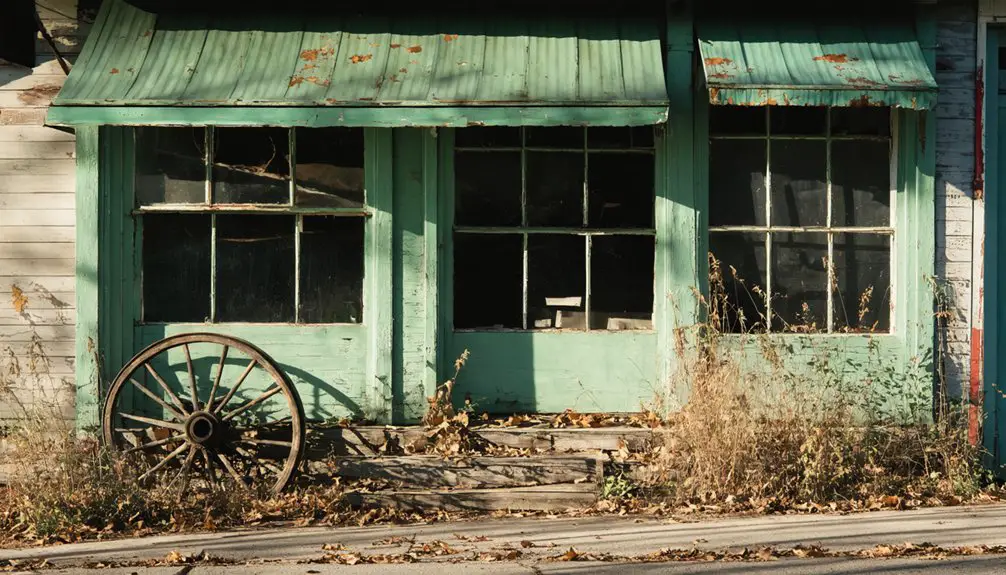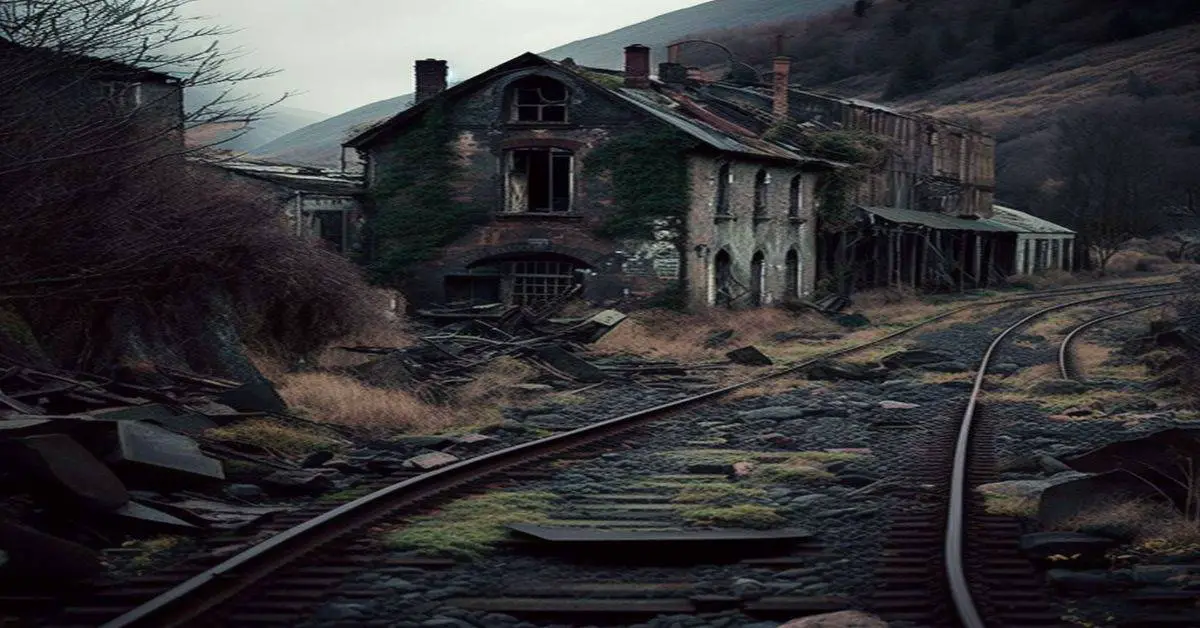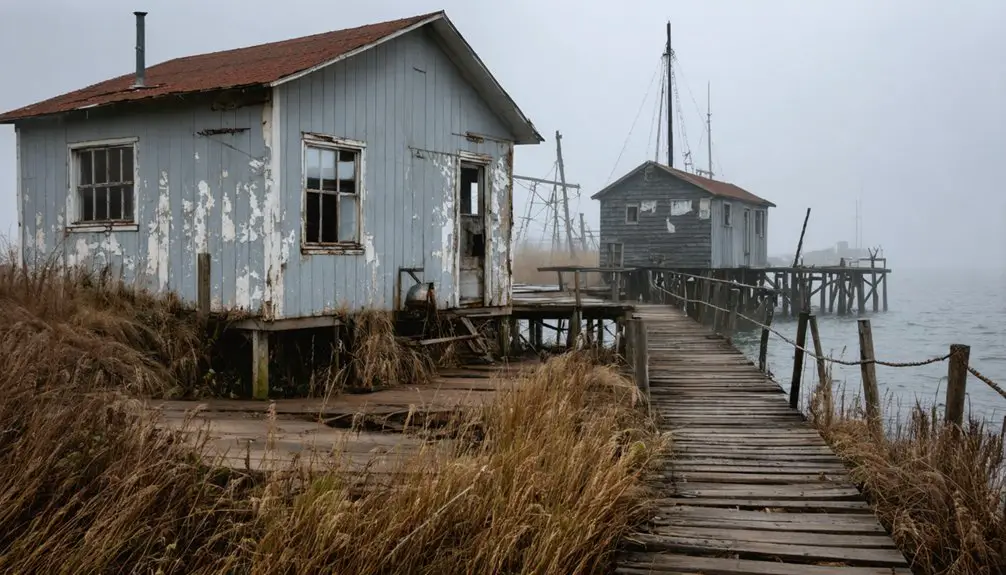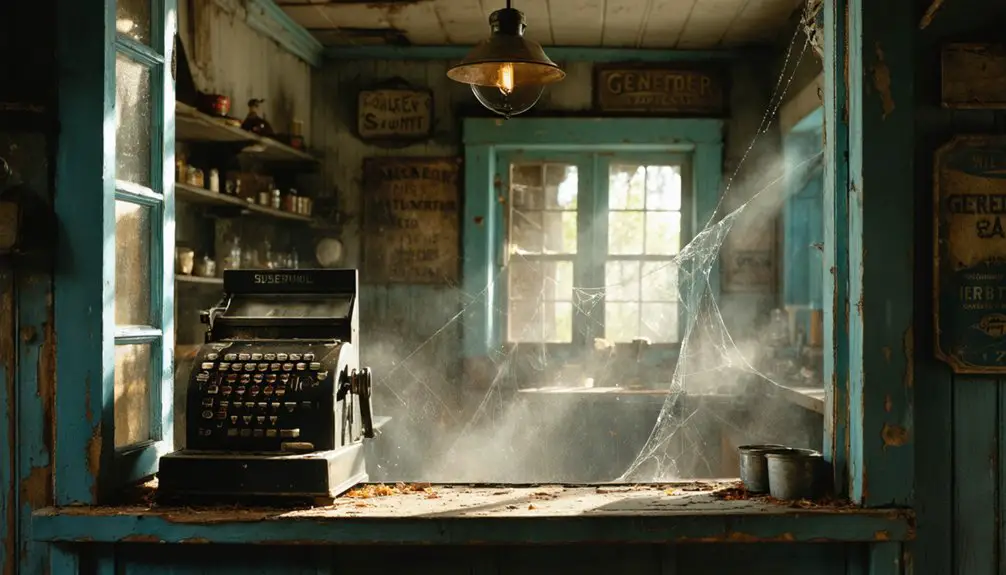You’ll find the ghost town of Old Belmont in southwestern Wisconsin, where it briefly served as the territory’s first capital in 1836. While the original settlement declined after losing the capital to Madison and missing essential railroad connections, a new Belmont emerged along the tracks in 1867. Today, you can explore the preserved Council House and Supreme Court building at First Capitol Historic Site, where Wisconsin’s political foundations took root amid the frontier’s challenges.
Key Takeaways
- Old Belmont transformed into a ghost town by 1867 when businesses migrated to new Belmont along the railroad tracks.
- The original settlement, later known as Grandview, declined due to lack of direct rail access and resource depletion.
- The historic Council House, once Wisconsin’s first territorial capitol, was reduced to use as a livestock barn after abandonment.
- Absence of industrial diversification and exodus of workers led to the original town’s complete economic downfall.
- The ghost town’s structures now serve as the First Capitol Historic Site, preserved for educational tours and historical interpretation.
The Birth of Wisconsin’s First Territorial Capital
When President Andrew Jackson established the Wisconsin Territory in 1836, the small settlement of Belmont emerged as its first territorial capital, marking a pivotal moment in Wisconsin’s pre-statehood era.
Wisconsin’s first territorial capital, Belmont, marked a historic shift in 1836 when President Jackson established the Wisconsin Territory.
You’ll find that territorial governance began in a modest 42×25-foot two-story building rented from John Atchinson, where Governor Henry Dodge convened the first legislative session on October 25, 1836.
The region’s 22,000 inhabitants, mostly concentrated in the lead-mining southwest, watched as their fledgling government faced significant legislative challenges.
The building’s cramped quarters, lack of heat, and absence of water made the work of establishing a new territory particularly difficult. After much debate, lawmakers chose to relocate the capital to Burlington and Madison in succession.
Despite these hurdles, the temporary capital served its purpose as the birthplace of Wisconsin’s territorial government, where legislators successfully enacted 42 laws during their brief session.
Early Political Life and Legislative Sessions
During the pivotal first Wisconsin Territorial Legislature, which convened from October 25 to December 9, 1836, lawmakers enacted 42 foundational laws that would shape the region’s future.
You’ll find that these 46 days of legislative influence established everything from territorial courts to transportation infrastructure, setting essential governance practices for an expanding frontier society.
Under Governor Henry Dodge‘s leadership, the council house buzzed with activity as legislators crafted laws for a territory that stretched across present-day Wisconsin, Iowa, Minnesota, and parts of the Dakotas.
While the session proved monumentally successful in creating the territory’s legal framework, it would be Belmont’s first and last moment of political glory. Similar to how disambiguation pages clarify multiple meanings of places and terms, Belmont’s brief political importance helped define Wisconsin’s early territorial status.
James Duane Doty’s powerful lobbying soon secured Madison as the permanent capital, leaving Belmont’s legislative halls to gather dust.
Building the Original Settlement
In a bold move to establish Wisconsin’s first territorial capital, Galena businessman John Atchison laid out Belmont’s ambitious design in 1835. His settlement strategy focused on creating essential governmental infrastructure through an innovative prefabrication approach.
You’ll find that Atchison’s plan included four key structures: a council house for legislative meetings, a lodging house for lawmakers, the territorial governor’s residence, and a courthouse.
To speed up construction, these buildings were manufactured off-site – likely in Pittsburgh and Galena – then shipped to Belmont for assembly. The settlement’s location wasn’t random; you’re looking at a carefully chosen site in the heart of the lead mining district, where most of the territory’s 22,000 residents lived and worked.
This placement reflected the region’s economic importance and population density. On September 9, 1836, Governor Henry Dodge officially declared Belmont as the temporary capital of Wisconsin Territory. The capital’s tenure was brief, lasting just 46 days before relocating to Madison.
The Railroad’s Impact on Belmont’s Destiny
Despite Belmont’s early promise as Wisconsin’s territorial capital, the arrival of railroad infrastructure dramatically altered the town’s destiny.
You’ll find that railroad expansion through southwestern Wisconsin forced a essential decision in 1867: the town had to move or die. The original settlement, later known as Grandview, watched helplessly as businesses and residents migrated to a new Belmont established strategically along the rail lines. The transformation was especially pronounced after the Galena and Southern Wisconsin Railroad completed its regional line in 1875.
The economic transformation was swift and decisive. When the Chicago and Northwestern Railroad built its station at Leslie in 1884, it cemented the region’s dependence on rail connectivity. Like the Chicago North Shore Line that would later revolutionize interurban transit, these rail developments determined which communities would prosper.
The railroad’s arrival in 1884 sealed Belmont’s fate, as new rail connections reshaped the economic landscape of southwestern Wisconsin.
Without direct rail access, the original Belmont couldn’t compete. The rails didn’t just carry goods and passengers; they determined which communities would thrive and which would fade into ghost towns.
A Tale of Two Locations: Old and New Belmont
The story of Belmont unfolds as a remarkable tale of two distinct locations, each marking a significant chapter in Wisconsin’s history.
You’ll find Old Belmont, established in 1835, briefly served as the territorial capital before political maneuvering and James Doty’s influence shifted power to Madison. The town was initially selected as the capital due to its proximity to a large mining operation. The historic Council House where territorial legislators once met was later used as a livestock barn in the years following the town’s decline. After losing its status, the original settlement gradually transformed into a ghost town, with its last remnants fading by 1867.
Just three miles away, New Belmont emerged along the railroad tracks, breathing fresh life into the community’s legacy.
While Old Belmont’s territorial politics and abandoned Capital House now draw history enthusiasts to its preserved grounds, New Belmont continues to thrive as a small but resilient community, showcasing how transportation routes and political decisions can dramatically reshape a region’s destiny.
Economic Forces Behind the Abandonment
Multiple economic forces converged to seal Belmont’s fate as a ghost town, creating a perfect storm of decline that you can still trace in the abandoned landscape today.
The town’s economic vulnerability stemmed from its heavy reliance on two primary sources: lead mining and territorial government functions. When the easily accessible lead ore depleted and the capital moved to Madison, Belmont’s foundation crumbled.
Belmont’s overdependence on lead mining and government roles proved fatal when both pillars collapsed, leaving only abandoned dreams behind.
You’ll find the echoes of labor migration in every empty building. As miners chased California’s gold rush dreams and government workers relocated to Madison, the town’s population dwindled. Like many mining settlements that once drew Cornish immigrant miners, Belmont couldn’t sustain its population as resources diminished.
Without railroad connections to larger markets and lacking industrial diversification, Belmont couldn’t compete with growing rail-connected cities. The exodus of workers and capital created a downward spiral, transforming a once-promising settlement into a stark reminder of boom-and-bust economics.
Preserved Heritage at First Capitol Historic Site
At Wisconsin’s First Capitol Historic Site, you’ll find two meticulously preserved buildings where the territory’s first legislature convened in 1836: the Council House and Supreme Court House.
Through decades of dedicated restoration efforts starting in 1910, these structures have been returned to their original sites and configurations after years of neglect and alternative uses, including the Council House’s stint as a livestock barn.
Today, you can tour these historic buildings from May through September, exploring the authentic rooms where Wisconsin’s earliest governance took shape and learning about the territory’s foundational laws through interpretive exhibits.
Original Buildings Still Standing
Standing as silent witnesses to Wisconsin’s territorial birth, two original buildings from the 1836 legislative session remain preserved at Belmont’s First Capitol Historic Site.
You’ll find the Council House, where territorial legislators debated Wisconsin’s future, and the Supreme Court House, which provided lodging for lawmakers before becoming Chief Justice Charles Dunn’s residence.
Both structures showcase the region’s historic architecture and legislative heritage, though they briefly served as livestock barns after their government roles ended.
Thanks to preservation efforts by the Wisconsin Federation of Women’s Clubs starting in 1910, these buildings were rescued, relocated to their original 1836 site, and meticulously restored.
Today, they’re freely accessible through the Wisconsin Historical Society, offering you a tangible connection to the territory’s pioneering governance.
Historic Tours and Education
Today’s visitors to Belmont’s First Capitol Historic Site can experience Wisconsin’s territorial heritage through engaging self-guided tours and educational programs.
You’ll step back to 1836 as you explore two meticulously preserved buildings that shaped the territory’s early government.
The site offers these visitor experiences:
- Self-guided tours of the Council House, furnished as it appeared during territorial legislative sessions
- Interactive exhibits in the Supreme Court building showcasing frontier life
- Customized group tours with personal guides for deeper historical insights
- Educational programs designed for families, schools, and camps
You’ll find free parking onsite, and admission is just $5 per person.
Remember to book group tours two weeks in advance by calling 608-987-2122 or emailing the site directly.
Capitol Grounds Restoration Progress
The meticulous restoration of Belmont’s First Capitol Historic Site stands as a symbol of Wisconsin’s commitment to preserving its territorial heritage.
You’ll find that Capitol restoration efforts have focused on both the Council House, restored in 1924, and the Supreme Court House, completed in 1956. These buildings represent the cornerstone of Wisconsin’s early government.
The grounds preservation at the site reflects the same dedication to historical accuracy you’ll see throughout the Wisconsin Historical Society’s properties.
While Madison’s ascension as the permanent capital led to Belmont’s decline, the First Capitol Site’s careful maintenance guarantees you can experience an authentic glimpse of territorial Wisconsin.
The preserved grounds and structures continue to tell the story of the state’s governmental origins, offering you direct connection to this pivotal period.
Legacy in Wisconsin’s Formation
Wisconsin’s first territorial capital played a pivotal role in shaping the state’s political foundation, despite its brief 46-day tenure. Through complex political alliances and territorial dynamics, Belmont’s legislature established essential groundwork that would guide Wisconsin’s development for generations to come.
You can trace Belmont’s lasting impact through these key contributions:
- Passage of 42 foundational laws that formed the legal bedrock of Wisconsin
- Creation of the first territorial governing framework spanning present-day Wisconsin, Minnesota, Iowa, and parts of the Dakotas
- Establishment of political processes that guided Wisconsin’s path to statehood in 1848
- Development of early resource management policies influenced by nearby mining operations
Though Madison ultimately became the permanent capital, Belmont’s brief but significant role marked the beginning of Wisconsin’s organized governance.
Modern Agricultural Evolution
While Belmont’s political foundations shaped early Wisconsin, modern agricultural landscapes tell a dramatically different story.
You’ll find today’s farmland marked by dramatic consolidation, with Wisconsin losing over 21,000 farms since 1997. Yet even as farm numbers drop, you’re witnessing an agricultural renaissance through technology. The average farm size has grown to 236 acres, while cutting-edge agricultural technology has pushed milk production to record levels of 24,385 pounds per cow.
You’re also seeing a transformation in who works the land. While 26% of producers are newcomers to farming, they’re entering an industry that’s increasingly diverse.
From being a national leader in ginseng and beet processing to supporting over 1,200 food processing facilities, Wisconsin’s agricultural evolution reflects a complex balance of tradition and innovation.
Frequently Asked Questions
What Were the Living Conditions Like for Early Belmont Settlers?
You’d face tough homesteading challenges in primitive log cabins, battling harsh winters without proper insulation. Your pioneer community would rely on local materials while managing basic farming and limited resources.
How Many People Lived in Belmont During Its Peak Population?
You’ll find that settlement patterns show a remarkable population growth during the territory’s early days, with peak numbers reaching around 22,000 people when mining and government activities were thriving.
Were There Any Notable Crimes or Incidents During Belmont’s Territorial Capital Period?
You won’t find major crime statistics during the territorial capital period – historical records show political disputes were heated but nonviolent, with no documented criminal incidents during the 46-day legislative session.
What Happened to the Original Residents After Belmont’s Decline?
After 1836, you’d find nearly 90% of residents scattered across the region, with relocation stories showing them moving toward railroad towns, Galena’s mines, or Lafayette County’s farms for better economic opportunities.
Did Any Famous Historical Figures Visit Belmont During Its Brief Capital Status?
You won’t find records of famous visitors during the capital period – only territorial officials and local speculators made their mark. The site’s historical significance stems from legislative actions, not celebrity encounters.
References
- https://pbswisconsin.org/news-item/southern-wisconsins-ghost-towns-leave-behind-vital-stories/
- https://www.britannica.com/place/Belmont-Wisconsin
- https://www.youtube.com/watch?v=G_5KlBLWuuk
- https://www.onlyinyourstate.com/experiences/wisconsin/first-captol-ghost-town-wi
- https://familydestinationsguide.com/vacant-town-rural-wisconsin/
- https://en.wikipedia.org/wiki/First_Capitol_Historic_Site_(Wisconsin)
- https://firstcapitol.wisconsinhistory.org/explore/history-first-capitol/
- https://www.vi.belmont.wi.gov/first-capital-wisconsin-territory
- https://tours.wisconsin.gov/pub/Content.aspx?p=History
- https://firstcapitol.wisconsinhistory.org



